J (Sidi Rezegh) Battery Royal Horse Artillery
| J Battery Royal Horse Artillery | |
|---|---|
| Active | 4 April 1805 – date |
| Country |
|
| Branch |
|
| Type | Artillery |
| Role | Close Support |
| Size | Battery |
| Part of | 3rd Regiment Royal Horse Artillery |
| Location | Hohne, Germany |
| Battle honours | Ubique |
J (Sidi Rezegh) Battery Royal Horse Artillery are a Close Support Battery of 3rd Regiment Royal Horse Artillery. They are currently based in Caen Barracks in Hohne, Germany.[1]
History
Madras Horse Artillery
J Battery was originally raised in India on 4 April 1805[2] as The Troop of Madras Horse Artillery, part of the Madras Army of the Honourable East India Company. With the formation of another unit on 6 January 1806 (the 2nd Half Squadron, Madras Horse Artillery), it was renamed as the 1st Half Squadron, Madras Horse Artillery and 1st Troop, Madras Horse Artillery[3] with the formation of a third troop (later M Battery, Royal Horse Artillery) on 25 January 1809.[4] By 5 August 1825, the Madras Horse Artillery had grown to 8 batteries and so was reorganized as two brigades; the battery was redesignated as A Troop, 1st Brigade, Madras Horse Artillery. The last redesignation under the Madras Army (as A Troop, Madras Horse Artillery) came on 4 January 1831 as the brigade system was discontinued and the Madras Horse Artillery shrank to 6 batteries in a single sequence (A to F Troops).[3]
As a result of the Indian Rebellion of 1857, the British Crown took direct control of India from the East India Company on 1 November 1858 under the provisions of the Government of India Act 1858.[5] The Presidency armies transferred to the direct authority of the British Crown and its European units were transferred to the British Army. Henceforth artillery, the mutineers most effective arm, was to be the sole preserve of the British Army (with the exception of certain Mountain Artillery batteries). On 19 February 1862, the Madras Horse Artillery transferred to the Royal Artillery as its 3rd Horse Brigade[lower-alpha 1] and A Troop became A Battery, 3rd Horse Brigade, RA.[3]
World War I

World War II
The battery was given the Honour title "Sidi Rezegh" for its action against a German attack during Operation Crusader, during which A Troop commander George Ward Gunn earned the Victoria Cross, and the battery commander Major Pinney was recommended for the VC.
Post war
Notes
- ↑ The original Horse Brigade Royal Artillery formed 1st Horse Brigade RA, the 1st Brigade Bengal Horse Artillery became 2nd Horse Brigade RA, the Madras Horse Artillery became 3rd Horse Brigade RA, the Bombay Horse Artillery became 4th Horse Brigade RA and the 2nd Brigade Bengal Horse Artillery became 5th Horse Brigade RA. The 3rd Brigade Bengal Horse Artillery was split between 2nd and 5th Horse Brigades RA. These brigades performed an administrative, rather than tactical, role.[6]
References
- ↑ "7th Armoured Brigade". Ministry of Defence (United Kingdom). Retrieved 8 May 2013.
- ↑ "3 RHA Batteries". Ministry of Defence (United Kingdom). Retrieved 8 May 2013.
- ↑ 3.0 3.1 3.2 Clarke 1993, p. 100
- ↑ Clarke 1993, p. 101
- ↑ "Official, India". World Digital Library. 1890–1923. Retrieved 2013-05-30.
- ↑ Frederick 1984, pp. 428–429
Bibliography
- Becke, Major A.F. (1935). Order of Battle of Divisions Part 1. The Regular British Divisions. London: His Majesty's Stationery Office. ISBN 1-871167-09-4.
- Clarke, W.G. (1993). Horse Gunners: The Royal Horse Artillery, 200 Years of Panache and Professionalism. Woolwich: The Royal Artillery Institution. ISBN 09520762-0-9.
- Frederick, J.B.M. (1984). Lineage Book of British Land Forces 1660-1978. Wakefield, Yorkshire: Microform Academic Publishers. ISBN 1-85117-009-X.
- Order of Battle of the British Armies in France, November 11th, 1918. France: General Staff, GHQ. 1918.
External links
| ||||||||||||||||||||||||||||||||